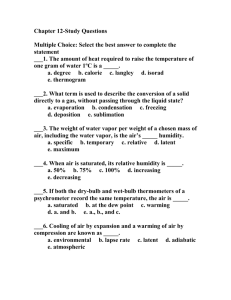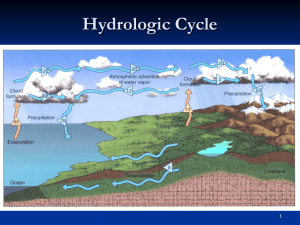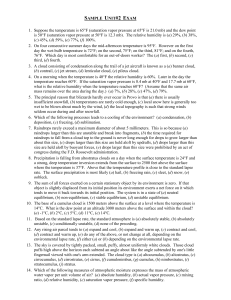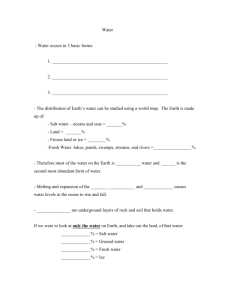Chapter 7
advertisement
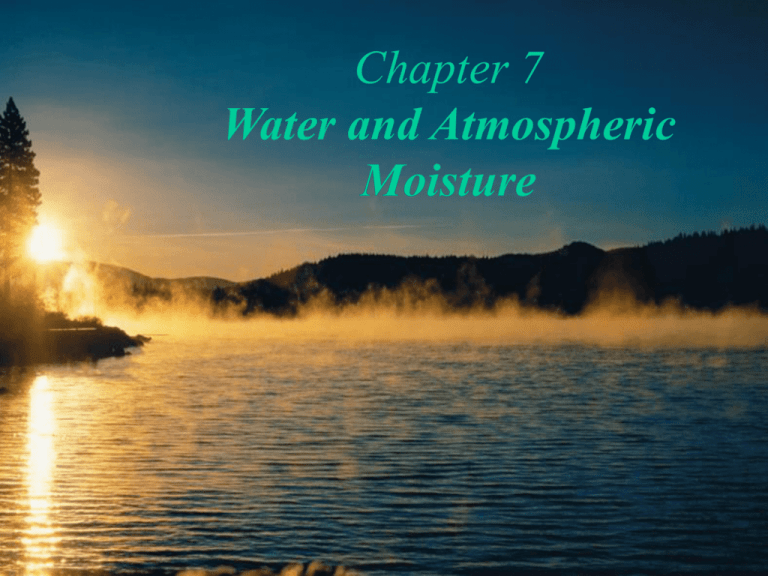
Chapter 7 Water and Atmospheric Moisture Water and Atmospheric Moisture Water on Earth Unique Properties of Water Humidity Atmospheric Stability Clouds and Fog Land and Water Hemispheres Figure 7.2 Ocean and Freshwater Distribution Figure 7.3 Unique Properties of Water Heat Properties Phase change Sublimation Latent heat Vaporization Condensation Heat Properties of Water in Nature Latent heat of sublimation Basics about Water: 2 atoms hydrogen + 1 atom oxygen make a covalent bond (very strong) so water is very stable Molecule is shaped like a bent paperclip •with the O side having a negative charge and the H side having a positive charge •the positive H side attracts the negative O side of a neighboring water molecule •called hydrogen bonding (weak) Hydrogen bonding Responsible for the surface tension of water •allows heavier things like bugs to stand on top of the surface of water •allows you to slightly overfill a glass of water without it spilling over. Responsible for capillary action •what happens when you set the edge of a papertowel down on a puddle of water? •The water is pulled into the dry part of the towel because each molecule is drawing the next molecule in •Same thing happens in soils, which will become important when we talk about the hydrologic cycle Phase changes 1. Sublimination 2. Condensation – Evaporation 3. Freezing - Melting Figure 7.4 Temperature (oC) Heat Transfer Figure 4.10 Boiling Water Vapor 100 Water 0 Ice Melting Heat added Latent and sensible heat Temperature (oC) Boiling 100 Water 0 Ice Melting Heat added Water Vapor Temperature (oC) Latent heat Boiling Water Vapor 100 Water 0 Ice Melting Heat added Water density Humidity Relative Humidity Saturation Dew point Expressions of Relative Humidity Vapor pressure Specific humidity Instruments Relative Humidity = Actual water vapor content of air Maximum water vapor capacity of air x 100 Dew Point Temperature Figure 7.7 Saturation Vapor Pressure Water Vapor in the Atmosphere Figure 7.9 Global Latent Heat Figure 4.19 Daily Humidity Patterns Figure 7.10 Seasonal Humidity Patterns Figure 7.10 Winter Summer Humidity Instruments – hair hygrometer Figure 7.13 Humidity Instruments – Sling Hygrometer Rate of evaporation is faster (more heat loss) when humidity is low Figure 7.13 Atmospheric Stability Will the Balloon float up or stay where it is (or sink downward)? If the air in the balloon is less dense than the air outside it floats up If the air in the balloon is more dense than the air outside it sinks Adiabatic Processes Figure 7.16 Clouds and Fog Cloud Formation Processes Cloud Types and Identification Fog Cloud Formation Figure 7.20 Moisture droplet Cloud-condensation nuclei Cloud Types and Identification Figure 7.22 Cumulonimbus Development Figure 7.23 Advection Fog – air migrates up or down and becomes saturated with water vapor Figure 7.24 Advection Fog –Valley Fog Figure 7.25 Advection Fog – upslope Fog Radiation Fog Figure 7.26 Fog Harvesting End of Chapter 7 Geosystems 5e An Introduction to Physical Geography Robert W. Christopherson Charlie Thomsen

